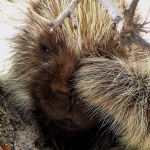Nature apparently admires adherence—I say this because there are so many different types of natural adhesives. From gecko’s feet, and their use of van der Waals forces to attach themselves to walls and ceilings, to the amazing mussel adhesive proteins (or MAPs) that have fascinated scientists and led to the development of MAP adhesive products for scientific products, medical applications—even for building products like PureBond, a formaldehyde- free plywood, there are a lot of ways stick things together in nature.
Not to be outdone are our prickly friends, the porcupines. According to this article in Medical News Today, Researchers at Massachusetts Institute of Technology (MIT) and Brigham and Women’s Hospital in the US have been studying porcupine quills to in the hopes of developing “a new class of adhesive materials.”
“We believe that evolution is the best problem-solver,” says Jeffrey M Karp, associate professor of medicine at Harvard Medical School one of the researchers. (Agreed.) He and Robert Langer (David H Koch Institute Professor at MIT) have been focused on the business end of the porcupine quill for answers to why it goes in so easily—and why it’s also so very difficult to get out. (Painfully difficult!)
The article goes on to say, “They made artificial devices with the same mechanical properties as the quill tips to see how best to exploit their ease of entry and difficulty of exit. For example, by exploiting the mechanisms that make it easy for the quills to penetrate skin, it might be possible to design less painful needles for use in medicine. And, by exploiting the properties that make quills difficult to remove, it might be possible to design adhesives that can bind internal tissues more securely.”
To test that that premise, they even made an adhesive patch that appears to work better than gecko-inspired bandages.
Yes—nature likes to make things stick!








